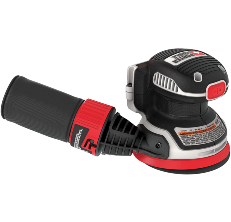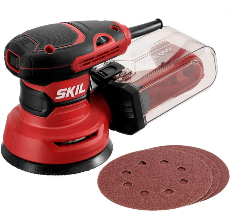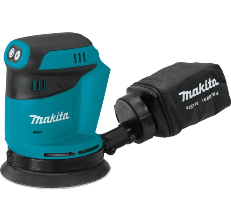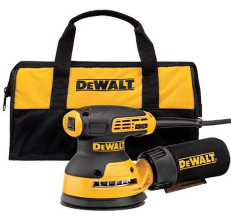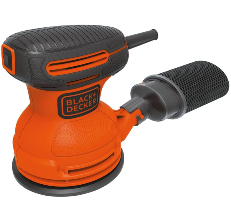Best Random Orbital Sander 2024
- Porter-Cable Random Orbital Sander - Best Overall
- Skil 5” Random Orbital Sander - Runner Up
- Makita Random Orbital Sander - Honorable Mention
- Dewalt Random Orbit Sander - Also Consider
- Black+Decker Random Orbit Sander
Whether your woodworking workload has increased or you’re simply fed up of sanding your projects by hand there is a clear power tool solution and we’re here with the answer. So if you want to find the best random orbital sanders of 2024, you’ve come to the right place. Today we’re exploring the best random orbit sander you’ll find for every budget and for every experience level. Random orbital sanders are an amazing tool that can save you time, energy and frustration so we’re digging into everything that you need to know in order to make the best purchase for your workshop and specific needs. Let’s dive in!
Here Are the Top Random Orbital Sanders of 2024
Porter-Cable Random Orbital Sander
– Best OverallThe porter cable orbital sander is the ideal for quick sanding on small to medium projects. Great for DIY-ers looking to cut back on sanding work, this tool will get the job done in no time and you won’t have to worry about cords or outlets as it’s entirely battery powered.
This 5 inch sander has enough power to take off an impressive amount of material in no time, saving you stress and strain but enough suction power on the dust removing mechanism to keep up with the collection. The batteries 20 V batteries are easily charged and the handle has a really comfortable grip that allows stability without compromising on accessibility.
- Lightweight design
- Vacuum port hooks up to hose
- Comfortable grip
- 12,000 OPM for efficient sanding
- Battery life can be insufficient for some
Skil 5” Random Orbital Sander
– Runner UpThe Skill random orbital sander is a thing of beauty. It packs so many high quality features in an affordable package that it’s definitely the winner in our book. The unit has a powerful motor and an impressive 13,000 OPM that can handle most materials without stress or strain. It’s vibration resistant and will be comfortable to wield even for longer periods of time.
This sander has a speed control function allowing you greater control on sanding power based on the material or type of project you’re working on. The dust collector is easy to maneuver and powerful to use making for a clean experience. Our only gripe with it is that it didn’t squeeze in swappable 6 inch pad functionality but for the price, you can’t really complain.
- Powerful 2.8 Amp motor
- 13,000 OPM for fast performance and smooth surfaces
- Speed control
- Only one disk size
Makita Random Orbital Sander
– Honorable MentionA great light weight sander, this unit will not cause stress and strain. It’s easy to carry, easy to use, doesn’t produce too many vibrations and will definitely get into all the tough spots. The batteries last long enough for any small to medium project and the finished product is a smooth and refined surface.
The makita random orbital sander will satisfy most hobbyists and get the job done regardless of the surface thanks to three speed settings that allows enough control for work on various types of material. Easy to use on horizontal and vertical pieces alike, it’s a great addition to any woodworking shop.
- Three speeds
- Great grip and handle
- Pad break for reduced free spin
- Does not come with a vacuum fitting
Dewalt Random Orbit Sander
– Also ConsiderThe Dewalt random orbit sander is a quality tool. It packs a lot of punch and it won’t let you down in the middle of a project. It can get into tight corners and close to the workpiece and it will provide the sanding capacity needed even for more heavy duty materials. Dewalt understands trade and they get tools. The dust collector is excellent and will actually work to keep the area around your work clean. It detaches and cleans easily and it’s also easily replaced by the vacuum port.
Great to grip and work with, this is a great tool that will last you a while. It will put in the work and never tire. The only issue is that it is a corded model so it will not have the same type of portability as a battery powered unit. But the sturdiness and results you can get with this tool are enough for us!
- Powerful 3 Amp motor and 12,000 OPM
- Short height allows better accessibility on the workpiece
- Fits dust collectors and vacuum connectors
- Corded
With only 2 Amps and weighing only 3 pounds, the Black+Decker orbital sander is a good tool for quick sanding. The motor won’t be powerful enough to handle hard material in a hurry but it will work just fine in most enthusiasts’ workshops and it’s high quality enough that it won’t let you down in the first six months.
Affordable and effective, this is the perfect tool for you if you’re not expecting to do professional work but want to make sanding a less tedious experience. A great sander for the price!
- Lightweight and easy to fit in small spaces
- 12,000 OPM delivers plenty of oscillation
- Great grip handle for extra comfort
- Only suitable for small projects
What Should You Consider Before Buying a Random Orbital Sander?
Random orbital sanders are simple tools. Sanding by hand is tedious and fixed rotating sanding can leave unseemly circular swirls in your workpiece. In comes the random orbit sander. By alternating the rotating motion with a random oval orbit, this machine ensures that you can take off a lot of material quickly, without having to worry about leaving marks. They provide a perfectly smooth finish. But how do you choose the best one for you? Here’s what to consider.
Things To Consider Before Buying a Random Orbital Sander
Disk size
Orbital sanders usually have two disk sizes – the 6 inches and the 5 inches. Which one you will need depends on the type of project you’ll find yourself working on. If your work area is large, the 6 inches will save time by being able to take off a lot of material quickly. The 5-inch is suitable for small to medium projects.
A great alternative is to find a random orbit sander that has replaceable disks so you can change between the 5 and 6 inches at will. If you think your project size will vary consistently, look for a tool that has this functionality.
The speed
Although most of your sanding will likely happen at maximum speed, having the ability to control and slow down the random orbit sander is very important if you’re going to be working with finer wood or more fragile material. A lower speed means you’ll have a lot more control over how much you’re taking off and it’s much easier to avoid sanding through your workpiece.
Additionally, if you think you’re going to be working with materials that are prone to heating, such as plastics, for example, a lower speed setting will be helpful to avoid that scenario as well.
The handle
These tools can have a two-hand grip, with one handle on the top and the other on the front of the orbital for better control. This also maximizes your ability to keep the tool flat against the work surface. While this is a great feature to have, you might find that for vertical sanding, or for getting in certain corners of walls or maybe even a wood carcass, the top handle alone allows you more flexibility. An additional grip on the front of the tool can impede your access.
Based on the kind of work you think you’ll be doing most often, select the right option for you. Alternatively, go for a random orbit sander with a removable front handle to get the best of both worlds.
Vibration
A random orbit sander that gives off a lot of vibration will create strain much faster than one that limits vibration. Unfortunately, it’s hard to tell from any of the features and functions that manufacturers list what the level of vibrations will be. The best way to do it is to look for other customers’ opinions or to try out the tool in a brick and mortar store, even if later you decide to purchase it online, for a better price.
Dust collection
When it comes to sanding, appropriate dust collection is a must. Not only would the dust be annoying, frustrating and hinder our work. It can also be hazardous to breathe in. Choose a random orbital sander with a good dust collection device and preferably a pleated filter for better and more long-lasting absorption. For big projects where you think a dust collection device would not be enough, it’s important to have the option of swapping out the filter for a vacuum collector. So if your random orbit sander can do that, you’ve hit the jackpot!
And even though the dust collection device will do a good job of keeping the dust from accumulating around the workshop, you may want to use a shop vacuum to clean up. The shop vacuum can effectively collect whatever the dust collector missed.
Power source
Just like most power tools, the random orbital sander can be powered in three main ways.
- Power cord
The most straightforward and usually inexpensive option, the power cord is simply plugged into an outlet and your tool is ready to go. It’s a great option but it won’t be suitable for everyone. If you won’t always have an outlet nearby you can check out one of the other two options.
- Cordless
Powered by rechargeable or changeable batteries, the cordless option has the advantage of being highly portable and easy to work with. No cord to worry about and no need to worry about where to find a socket. However, this option also has its drawbacks. The tool will likely have a limited operability time before the batteries run out, so if your project requires hours of sustained work you might want to look elsewhere. Cordless random orbital sanders can take a while to recharge.
- Pneumatic
If you’re looking for all of the power that a corded tool can offer with some of the portability of a cordless one, the pneumatic option is probably your best bet. If your compressor can produce at least 40 cubic feet of air per minute, you should be able to comfortably use it in your orbital sanding work.
RPM vs OPM
RPM means revolutions per minute and it roughly refers to how many times the disks on your random orbit sander will spin in a given minute. Of course, it’s not a perfect measurement as the disks don’t simply spin statically on an axis. They also oscillate randomly. RPM can be a good approximate indicator of the kind of intensity you can expect from your sander, but it’s not a perfect one.
A better measurement is OPM or Orbits Per Minute which tells you how many random orbits your tool will be doing. This is a more representative metric of what your tool is actually doing.
Motor power
The motor power for a random orbital sander can range from 2.5 to 3.3 Amps and it’s one of the most important aspects in determining the strength of your sander. Some brands might boast higher OPMs, but without the motor power to back it up, they can fall short of competitors who limited OPMs but increased Amps. If you anticipate frequent heavy-duty sanding, consider purchasing a unit with a better motor.
How To Use a Random Orbital Sander
This video from House Improvements will show you how to use a random orbital sander:

People Also Asked
An orbital sander has sanding disks that only move in a circular motion. The tool is great for rough work but it can leave circular shapes in the wood. A random orbital sander also oscillated oval orbital movements thus creating a smoother finish.
The random orbital sander is a power tool used for quickly sanding a lot of material while leaving a smooth surface behind.
Yes, random orbital sanders can be a worthwhile investment. They’re precise and leave a smooth sanded surface behind while also being powerful enough to remove a lot of material in a short period of time with little strain on behalf of the one using it.
Random orbital sanders are used on a variety of surfaces from wood to plaster and even plastics or acrylics. They are versatile tools that can save you a lot of hassle. Some materials can be more fragile or heat sensitive than others so make sure to always adjust your speed.
The Woodsmith Review Team’s product reviews and in-depth guides are here to help you choose the best tools and gear to build great-looking projects confidently. Woodsmith is reader-supported: When you buy through links on our site, we may earn an affiliate commission. Large language models (like Artificial Intelligence) may have been used in the research and creation of the content.
Inquiries regarding specific articles or product testing should be sent to aimperiapt@gmail.com

